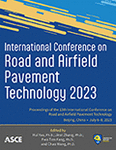Point Cloud-Based Pavement Crack Extraction Using MSAC and KNN Algorithm
Publication: International Conference on Road and Airfield Pavement Technology 2023
ABSTRACT
Crack evaluation is critical to the pavement condition acquisition and preservation. The current pavement crack detection method based on two-dimensional images is relatively mature, but the extraction accuracy is quite dependent on the quality of the images themselves, which is greatly affected by various conditions. To tackle these problems, this paper proposes a pavement crack extraction method based on three-dimensional laser point cloud, which jointly uses the M-estimator sample consensus (MSAC) algorithm and K-nearest neighbor (KNN) algorithm. According to the feature that most of the crack points are below the road surface, the MSAC algorithm is used to fit the pre-processed point cloud to the plane and separate the crack point cloud from the pavement texture points. Experimental results exhibit that the fitting effect is better when the maximum point-to-plane distance is 6 mm. The distance density is characterized by the nearest neighbor distance of each point calculated by KNN algorithm. Results show that it is better to use 0.95 times the average distance as the threshold to filter the crack area. The YOLOv5 deep learning model is conducted to identify the crack images, and the results indicate that the proposed method has a good performance in reproducing the morphology of cracks.
Get full access to this article
View all available purchase options and get full access to this chapter.
REFERENCES
Cao, T. (2018). “Research on Key Technology of Pavement Crack Survey Based on 3D Point Cloud and Image Data.” Chang’an University.
Cao, W., Liu, Q., and He, Z. (2020). “Review of pavement defect detection methods.” Ieee Access, 8, 14531-14544.
Gao, J. (2020). “Research on Target Edge Detection based on 3D Point Cloud.” Beijing Jiaotong University.
Ghahremani, M., Williams, K., Corke, F., Tiddeman, B., Liu, Y., Wang, X., and Doonan, J. H. (2021). “Direct and accurate feature extraction from 3D point clouds of plants using RANSAC.” Computers and Electronics in Agriculture, 187, 106240.
Grilli, E., Menna, F., and Remondino, F. (2017). “A review of point clouds segmentation and classification algorithms.” The International Archives of Photogrammetry, Remote Sensing and Spatial Information Sciences, 42, 339.
Kheradmandi, N., and Mehranfar, V. (2022). “A critical review and comparative study on image segmentation-based techniques for pavement crack detection.” Construction and Building Materials, 321, 126162.
Li, W., Huyan, J., Tighe, S. L., Ren, Q., and Sun, Z. (2017). “Three-dimensional pavement crack detection algorithm based on two-dimensional empirical mode decomposition.” Journal of Transportation Engineering, Part B: Pavements, 143(2), 04017005.
Mahdaoui, A., and Sbai, E. H. (2020). “3D point cloud simplification based on k-nearest neighbor and clustering.” Advances in Multimedia, 2020, 1-10.
Ni, H., Lin, X., Ning, X., and Zhang, J. (2016). “Edge detection and feature line tracing in 3D-point clouds by analyzing geometric properties of neighborhoods.” Remote Sensing, 8(9), 710.
Pinkham, R., Zeng, S., and Zhang, Z. “Quicknn: Memory and performance optimization of kd tree based nearest neighbor search for 3d point clouds.” Proc., 2020 IEEE International symposium on high performance computer architecture (HPCA), IEEE, 180-192.
Singh, P. S., Nongsiej, I. M., and Marboh, V. (2023). “The Segmentation of Drone Image derived 3D Point Cloud Using a Combination of RANSAC, DBSCAN and Clustering Methods.” Proceedings of UASG 2021: Wings 4 Sustainability: Unmanned Aerial System in Geomatics, Springer, 267-278.
Taunk, K., De, S., Verma, S., and Swetapadma, A. “A brief review of nearest neighbor algorithm for learning and classification.” Proc., 2019 International Conference on Intelligent Computing and Control Systems (ICCS), IEEE, 1255-1260.
Wang, G., Liu, S., Jiang, R., and Zhang, X. (2017). “Research on building crack extraction method based on laser point cloud.” Laser & Infrared, 47(07), 896-899.
Wang, Y., Ewert, D., Schilberg, D., and Jeschke, S. “Edge extraction by merging 3D point cloud and 2D image data.” Proc., 2013 10th International Conference and Expo on Emerging Technologies for a Smarter World (CEWIT), IEEE, 1-6.
Xu, G., Pang, Y., Bai, Z., Wang, Y., and Lu, Z. (2021). “A fast point clouds registration algorithm for laser scanners.” Applied Sciences, 11(8), 3426.
Yu, H. (2015). “The Study of Pavement Cracks Automatic Identification Technology Based on 3D Laser Point Cloud.” Hubei University of Technology.
Zhang, J., Cao, D., and Zhang, J. (2023). “Three-dimensional modelling and analysis of fracture characteristics of overlaid asphalt pavement with initial crack under temperature and traffic loading.” Construction and Building Materials, 367, 130306.
Information & Authors
Information
Published In
History
Published online: Feb 6, 2024
ASCE Technical Topics:
- Algorithms
- Computer networks
- Computing in civil engineering
- Continuum mechanics
- Cracking
- Detection methods
- Engineering fundamentals
- Engineering mechanics
- Environmental engineering
- Equipment and machinery
- Filters
- Filtration
- Fracture mechanics
- Gravels
- Highway and road management
- Highway transportation
- Highways and roads
- Infrastructure
- Internet
- Lasers
- Mathematics
- Methodology (by type)
- Pavement condition
- Pavements
- Solid mechanics
- Transportation engineering
- Water treatment
Authors
Metrics & Citations
Metrics
Citations
Download citation
If you have the appropriate software installed, you can download article citation data to the citation manager of your choice. Simply select your manager software from the list below and click Download.
